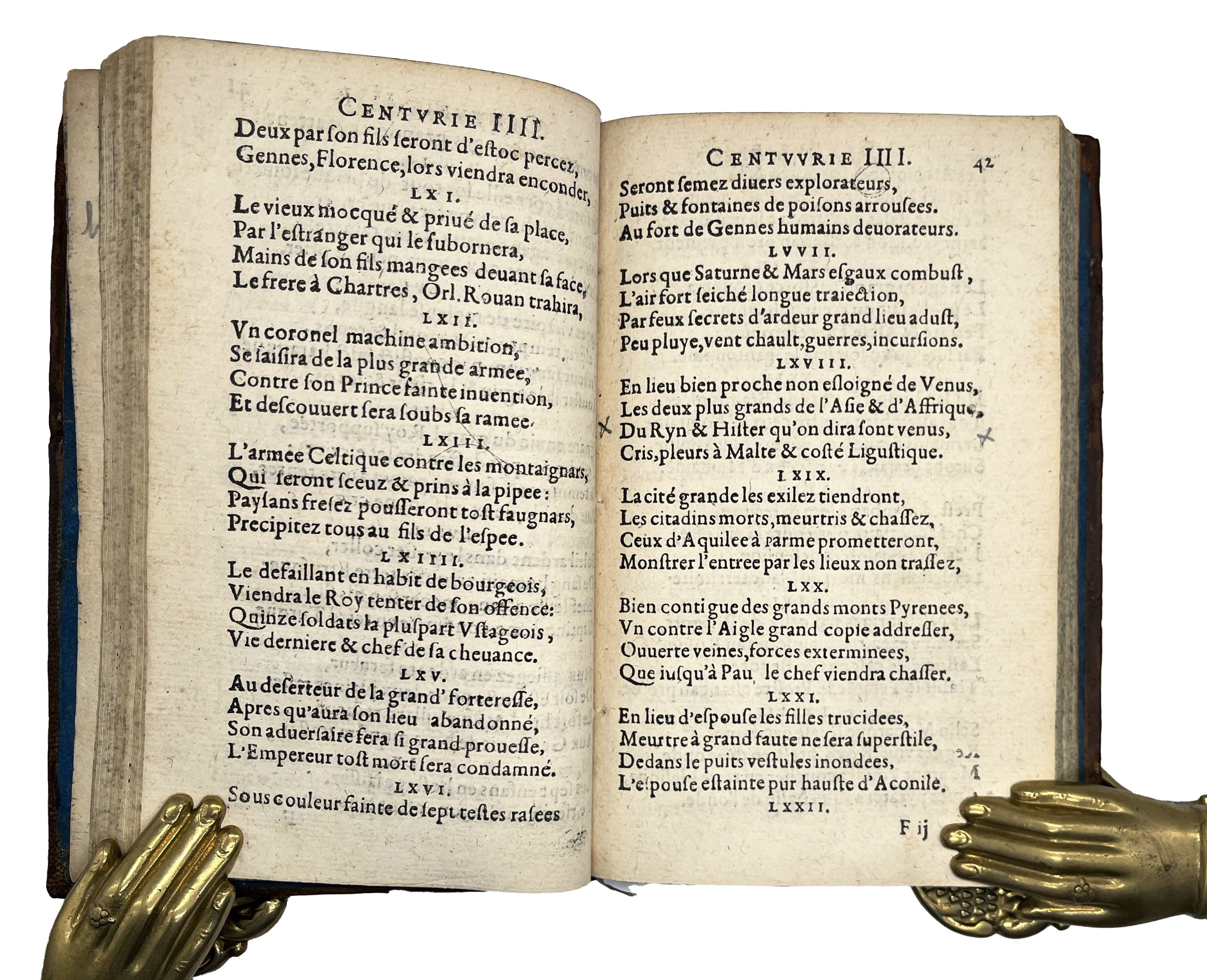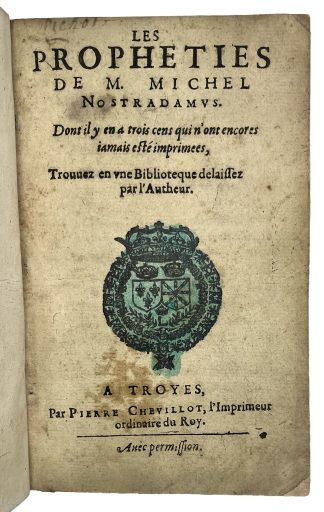NOSTRADAMUS, Michel de.
Les Propheties.
Troyes, Pierre Chevillot, not before 1610.£2,750.00
8vo. Two parts in one (foliation and collation continuous) ff. 132; A-O8. Roman letter, some Italic. Woodcut printer’s device on both titles, (the first with Louis XIII’s arms coloured in blue), woodcut initials and typographical headpieces, ‘Pichot’ in early hand at head of title, ‘Bidoni de Grivins’, in later hand on fly, early shelf mark to f.e.p, some C19 pencil marks and annotations. Light age yellowing, tear to lower outer corner of L1, touching a few letters, blank upper outer corners of last four leaves with early restoration, affecting pagination on last, replaced in early mss. A good copy, crisp and clean, in c.1700 calf, spine gilt with a semé of small tools, rebacked with original spine laid down, corners and edges restored, all edges sprinkled blue.
Charming popular edition of the prophecies of Nostradamus printed by Pierre Chevillot, in imitation of the earliest editions, here without date. This edition supposedly derives from a manuscript given by the author’s nephew Michael Nostradamus to the editor Vincent Sève, bringing the text up to date from 1597. All other editions of Nostradumus’ centuries produced by Chevillot at Troyes were published between 1605 and 1629 and the first title bears the arms of Louis XIII who acceded to the throne in 1610. The first part contains the famous dedication to his son and the second to Henry II. The work was originally published in three parts, the first containing 353 verses. The second part was printed in 1557 and added 289 further prophecies; the third and final part of 300 new verses was printed in 1558, posthumously. These rhymed quatrains were grouped into nine sets of 100 and one of 42, called “Centuries”. Nostradamus claimed each prediction was based upon his astrological reading of particular events, though it is evident that a great deal is copied from earlier Latin authors such as Livy, Plutarch and other classical historians and many taken from Richard Roussat’s Livre de l’estat et mutations des temps (1549–1550). The Mirabilis Liber of 1522, which contained a wide range of prophecies by Pseudo-Methodius, the Tiburtine Sibyl, Joachim of Fiore, Savonarola and others was also a well used source. His considerable initial success was based on the fact that he was one of the first to re-paraphrase these prophecies in French. Further material was gleaned from the De honesta disciplina of 1504 by Petrus Crinitus, which included extracts from Michael Psellos’s De daemonibus, and the De Mysteriis Aegyptiorum, a book on Chaldean and Assyrian magic by Iamblichus, a fourth-century Neo-Platonist. Most of the quatrains deal with disasters, such as plagues, earthquakes, wars, floods, invasions, murders, droughts, and battles—all undated and based on foreshadowings by the Mirabilis Liber. The work was remarkably popular and has been reprinted over two hundred times since its first appearance. Popular modern interpretations of the quatrains have shown them to predict the French Revolution, Napoleon, Hitler, the nuclear destruction of Hiroshima and Nagasaki, and even the death of princess Diana and the events of 9/11. An important contemporary theme was fear of an impending invasion of Europe by Muslim forces, headed by the expected Antichrist, directly reflecting the Ottoman invasions of the Balkans. The work was published within the context of a general fear of an imminent apocalypse. A rare and charming popular edition.
USTC No. 7716. Caillet 8068. Chomarat 177. Pettegree, ‘French Vernacular Books’, 39675. Not in Cantamessa.In stock







